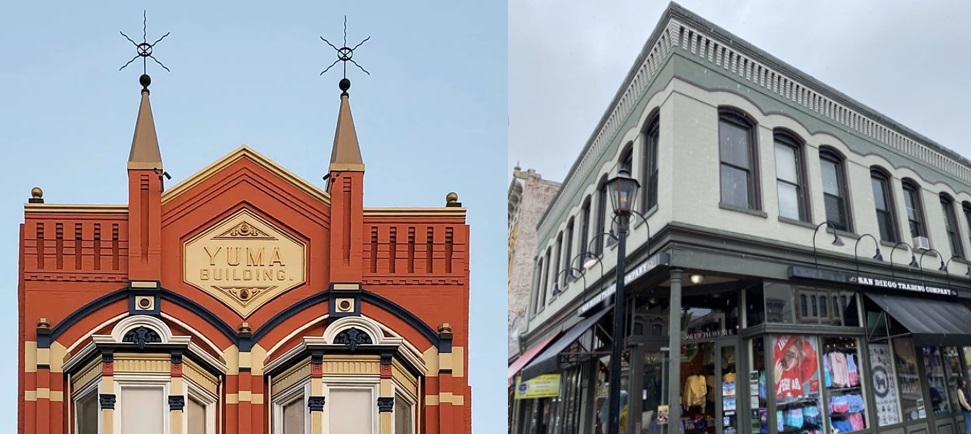Landmarks
The Timken and the Yuma Revisited
In honor of both Black History month (February) and Women’s History month (March), it is most appropriate to revisit two of the Gaslamp’s iconic structures, which impacted both women and Black history. Although they are widely known for not only their architecture, but for the early San Diego businessmen who built them, these buildings played an important part in other areas of the business community.
The Timken Building
(1894)
SW Corner of Fifth and Market Street
Architect: Joseph Falkenham
Architectural Style: Romanesque/Commercial
Realtors will tell you that “location, location, location” is everything, but this prime piece of corner real estate had a rather inauspicious beginning. In its early years, after its initial sale in 1870 by Alonzo Horton for $1,500, the property changed hands on a regular basis. Each time it sold; the property increased in price. By the time Henry Timken purchased the parcel in 1887, the price had risen to $50,000!
Mr. Timken acquired his great wealth from his inventions of the Timken spring, which is used in various types of vehicles, and the Timken roller bearing, which enabled larger loads to be hauled by horses. Both were essential to San Diego’s growing economy. He was referred to as an “Eastern capitalist,” as he moved his family from Missouri in 1887, and promptly invested $2,000,000 in local real estate. He was not only a capitalist, but also a philanthropist. Through the Timken Foundation, we have the Balboa Fine Arts Museum, the Timken Gallery, areas of Pomona College and three million dollars towards the Scripp’s Clinic and Research Foundation.
When Timken purchased the property, it had four framed, one-story structures housing the Pioneer Saddle Shop, a mattress factory, a fruit store and dwelling, and a coffee house. All of the businesses faced Fifth Avenue. Storefronts facing H St. (now Market St.) did not appear until after the Timken Building was erected.
After 1894, there were three business locations on the H St. side. The businesses included second-story furnished rooms, a restaurant, a billiard hall, a tailor shop and a men’s clothing store. In 1915, the furnished rooms, formerly called “The Seattle,” was changed to “The Brighton” in 1916.
The Brighton once housed, and was run by, Mrs. Anna Brown, a well-known African American businesswoman. Mrs. Brown served as Brighton’s proprietor between 1924 and 1927. Prior to her tenure at the Brighton, Mrs. Brown was a business partner of George Ramsey at the Yesmar Hotel (later the Anita Hotel). Ramsey was considered the unofficial mayor of the African American community and was best known as the owner of the Douglas Hotel and the Creole Palace. Anna served as manager of the Yesmar until 1923. Additionally, Mrs. Brown owned several boarding houses of her own. She was one of the most visible African American businesswomen in early San Diego.
Currently, the San Diego Trading Company occupies the street level of the Timken Building, and the upstairs is devoted to seven studio apartments and four one-bedroom apartments.
The Yuma Building
(1882-1888)
631 Fifth Avenue
Architects: Armitage and Wilson
Architectural Style: Italianate Baroque Revival
The stately building with the twin spires that graces Fifth Avenue is said to be the first structure in the Gaslamp to be made entirely of brick. This impressive building was called the Yuma because of its owner’s previous business association. That owner, Captain Alfred Henry Wilcox, had been involved with the Colorado Steam Navigation Company, and the first and last stop on their river excursions was Yuma. It was also Captain Wilcox’s base of operations.
He originally came to San Diego as a mate on the USS Invincible, and later returned as the ship’s captain. He was charged with the task of surveying and mapping the San Diego River, and ultimately constructing a dam to turn part of the river into a “false bay.” We now call this Mission Bay. He married Maria Antonia Arguello, daughter of a wealthy landowner, and became involved in numerous successful commercial enterprises. Captain Wilcox acquired several real estate properties, including a ranch in Santa Ysabel, a mansion on Second Avenue, and property on La Punta, the southeast corner of San Diego Bay. He additionally had banking interests in Los Angeles and San Francisco.
Captain Wilcox acquired the lot on Fifth Avenue from E.W. Tebbutt and began construction on the Yuma in 1882. Sadly, he died the following year, and his wife finished the construction upon the settlement of his complicated estate. The completed structure is as it stands today. Mrs. Wilcox occupied the premises for a time, but then retired to the ranch.
The Yuma Building, a classic example of Victorian architecture, is three stories high with a basement. The street level walls are 16” thick and the walls on the second and third floors are 12” thick. The front was iron-clad and featured bay windows. A large skylight lit the upper two stories. The structure contained 16 rooms and a store on the ground level. A lovely stairway graced the northwest corner. The basement was used for storage and cellars.
Throughout the years, a variety of businesses occupied the building including a Japanese Bazaar, medical offices, an insurance broker and a dry goods store. In 1901, the upper floors were converted to furnished rooms, and were operated as the “Santa Ysabel.” In 1910, the rooms became known as “The Grant.”
On November 11, 1912, the Grant gained notoriety for becoming the ultimate stop of the Great Raid of 1912. As the California- Panama Exposition was coming to San Diego in 1915, Police Chief Keno Wilson was receiving increasing pressure from several civic minded organizations, including the Ladies’ Purity League, to clean up the Stingaree, as the area was called. Due to the transient nature of much of the clientele, many who were sailors on ships stopping at the foot of Fifth Avenue, the Stingaree had become famous for its numerous saloons and accompanying brothels. Early on a Sunday morning, the raid began, and by the end of the day, Keno Wilson had rounded up 138 ladies of the evening. The ladies were gathered in front of the Grant, and Chief Wilson gave them a choice – either reform or get out of town. The city would pay for their train ticket. Only two decided to reform. One became a telegraph operator and the other went insane, likely because of a social disease. The other ladies then marched up Fifth Avenue to the Santa Fe Depot, where they were instructed to purchase tickets. Unfortunately, they did not receive complete instructions, as most of them purchased round-trip tickets and returned the next day!
City directories indicate that the Grant lasted well into the 1950s, not as a brothel but as furnished rooms. At times it was listed under the proprietor’s name. African Americans were listed as lodgers in the 1930 census and in the 1936 Black Directory. More notably, in 1925, Mrs. Carrie De Frantz is listed as the proprietor.
The 1930 census lists Mrs. De Frantz as 42 years old, African American, originally from Maryland, and in ensuing censuses lists her as manager of the Grant for 20 years. This, along with documented Black renters, establishes the presence of the African American community in the central Gaslamp, as well as the role of African American women in managerial positions.
The property remained a single room occupancy hotel until 1989 when it came on the market. It was purchased by Marsha Sewell, an interior designer, and her late husband, Mike Shea, an airlines pilot, who both had a passion for real estate. The building was in poor condition, and a major restoration effort was in order.
The upper two floors , a two-story showplace townhouse, were completed in 1992, and Marsha lived in the house until 2003, after Mike’s passing in 2001. This exquisitely restored home, complete with four fireplaces, has been the site of many cultural and civic events, and has hosted numerous dignitaries. Although Marsha no longer owns the property, its stately presence continues to grace the Gaslamp.
The highlighting of Mrs. Brown’s and Mrs. De Franz’s accomplishments casts a more complete view of downtown San Diego’s development and the contributions of our diverse population.
Sandee is the Historian/Lead Tour Guide at the Gaslamp Quarter Historical Foundation. She can be reached at [email protected].

